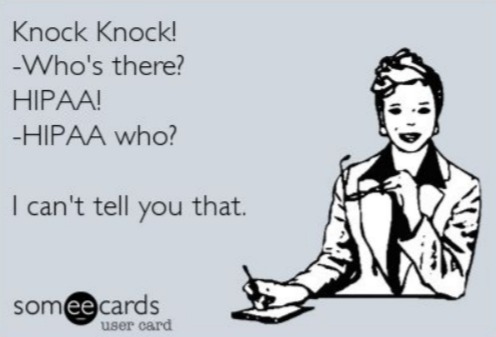For caregivers of people with schizophrenia, one of the most difficult barriers to assisting in our loved ones’ treatment can be the misinterpretation of the Health Insurance Portability and Accountability Act (HIPAA). Even though this Act became law in 1996, there is still much confusion about what HIPAA does and does not do.
HISTORY
The purpose of HIPAA is to help people carry their health insurance from one company to the next, as well as to streamline the movement of medical records from one health care institution to another. In addition, HIPAA includes a strong focus on recognizing and enforcing the rights of psychiatric patients in order to protect the privacy of their medical records.
The increased use of computers and electronic records made it necessary to enact legislation to protect this electronic information. Remember when we had to pick up lab results or x-rays and hand carry them to a specialist’s office? The convenience of electronically sharing records brought with it concerns about privacy. Could any doctor’s office request copies of your records? Of course we didn’t want that. HIPAA is here to help with guidelines on how and when our medical records can be shared. HIPAA also allows us to keep our health insurance when we leave a job, at least for a short period of time (we all know about COBRA, right?).
For families dealing with mental illness like schizophrenia, the important part of HIPAA law is the Privacy Rule. A Covered Entity, i.e. a provider or insurance company, has a duty to protect a patient’s personal medical information. A Covered Entity is a provider or insurance company who uses an electronic means to file claims, check for eligibility, etc. Privacy is a very important part of the treatment of mental illness, as patients need to feel safe when disclosing information. We get that. But, I’d wager, it’s equally important for family/caregivers to be included in treatment plans and consulted when they have important information for the patient’s treatment team. Often, caregivers are the record keepers and historians for the patient. Without our input, treatment won’t be as effective.

CLARIFICATIONS
Recently, the Department of Health and Human Services (HHS) issued clarification on HIPAA policy for how and when our loved ones’ information can be shared. On the HHS website, it now includes the following list of who and when someone can receive information about your loved ones’ treatment:
- For treatment and care coordination
- To pay doctors and hospitals for the patient’s health care
- To share information with family, relatives, friends, or others identified by your loved one as being involved with their health care or health care bills, unless they object
- To make sure doctors give good care and nursing homes are clean and safe
- To protect the public’s health, such as by reporting when the flu is in your area
- To make required reports to the police, such as reporting gunshot wounds
The third bullet point is the one that’s most confusing. The language there is relatively new and is intended to be a clarification, but it’s certainly not clear. Let’s look at an example you’ve likely heard about:
On December 14, 2012, Adam Lanza took guns from his mother’s gun cabinet and shot and killed her. He then went to Sandy Hook Elementary School and opened fire, killing twenty students and six staff members. There had been killings before, but this tragedy was met with outrage. In response to Sandy Hook, the Department of Health and Human Services issued a two-page clarification for Covered Entities so that they would know when to share information and when not to share it. You can read the letter here:
This letter clarifies that it is permissible to release information to law enforcement, family, school officials, or anyone who may need to know if there are any indications of possible dangerousness in a patient. This clarification covers only threats of harm or dangerousness as an exception to the Privacy Rule. According to the New York Times, medical experts at Yale had notified Adam’s mother that “drastic measures” were recommended to help Adam prior (but how long prior is not clear) to the events at Sandy Hook. These, reports the New York Times, were “largely unheeded.” Adam is said to have suffered from anorexia, anxiety, and obsessive compulsive disorder. A report noted in the New York Times concludes that Adams untreated mental illness was a predisposing factor the events that followed. And the question for our consideration today is did HIPAA – or an interpretation of it – play a role in how information about Adam was handled and if it had been handled differently, what would have been the result? Could possible warning signs been shared in a manner that could have been tragedy averted?
Shortly after the HHS released their clarifications, hearings were held in the Energy and Commerce Commission on Capitol Hill. On April 26, 2013, under oath in front of the Energy and Commerce Committee, then director of the Office for Civil Rights Leon Rodriguez stated, “If a patient is unconscious or otherwise is incapacitated, the doctor can share information with family members or friends if the doctor determines, based on professional judgment, that doing so would be in the patient’s best interest.” Again, this is open for interpretation. One could argue that a person on an involuntary psychiatric hold must surely be mentally incapacitated. Unfortunately, many patients’ rights advocates don’t see it that way. Ultimately, the fact is that if a doctor believes it is in the best interest of a patient, then the doctor may communicate with a family member or caregiver. When my family member is deeply psychotic and hospitalized, he sometimes won’t allow the staff to communicate with me. But since I manage his medications and his medical appointments, it’s important for me to be included in his treatment while inpatient. I have information pertinent to his treatment. If he’s too ill to consent to my involvement, the doctors could miss important pieces of information for his treatment.
Recently, the same information was reiterated by HHS. But the message is still unclear. Legislation passed in 2016 sought to amend HIPAA to allow certain pieces of information, such as medications and treatment plans, to be made available to family/caregivers, but the HIPAA piece is still being worked out by HHS.
HOW DO WE HELP OUR LOVED ONES WHEN WE FEEL HANDCUFFED BY HIPAA?
If you’re a caregiver of someone with schizophrenia, you know the drill. You ask about an appointment for your loved one and are met with a blank stare. The person behind the desk says they can’t release any information about the patient. Inside, you seethe. Calmly, you explain that you aren’t asking for information, you’d just like to schedule an appointment. The clerk tells you they can’t help with that. Or, you’ve just spent a few days in a hospital ER. Your family member finally got a bed at a psychiatric facility. He’s being transported and should have been admitted by now. So you call the front desk and ask what unit he’ll be on, so you can call the nurse or social worker to fill them in on what precipitated his hospitalization. Of course, they can neither confirm nor deny that he’s there. But you know he is, as the ER staff told you this. So what do you do?
One technique I’ve used with success when my family member has been hospitalized is to send a concise one-page fax to the treatment facility. In this fax, I indicate the patient’s name and my relationship to him (that I provide care for him) and that I have specific information that is important for his treatment. I don’t provide the information in the fax, however, as the goal is to get the treatment team’s interest so that I get a call-back. I also state that I understand they are bound by HIPAA and that I am not asking for information. Rather, I am asking to be heard so that the doctor can provide better treatment to my family member. Keep the letter short and respect that staff fear HIPAA violations. If possible, use an efax so you will have a record of exactly what you sent as well as when you sent it.
Gently educating treatment providers can help, as well. I have handed out printouts of the HHS HIPAA updates and clarifications, and discussed what these clarifications mean to family members, clients, and the treatment team. Keep an open mind and don’t push. As my grandmother often said (and yours probably did, too!), “You get more flies with honey than you do with vinegar.” In other words, be nice if you want the treatment team to work with you. That’s the goal, isn’t it?
I hope this information is helpful to you. Please comment with questions, suggestions or other information. For information about how to receive caregiver-centric support, stress management, and disease specific tips and techniques (from the convenience and privacy of your own home via telehealth), visit MyHealios. – Kathy Day
We provide financial planning and strategy support that has been specifically built for caregivers of someone coping with a SMI. We would welcome the opportunity to discuss our approach with you. Reach out today at ppeeler@intfingroup.com or jacosta@intfingroup.com to set a time to speak confidentially over the phone.
Kathy Day is not affiliated with Integrated Financial Group or LPL Financial. Securities and Advisory services offered through LPL Financial, a Registered Investment Advisor, Member FINRA/SIPC.
